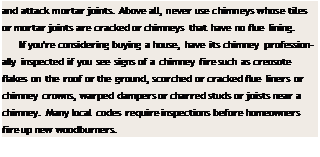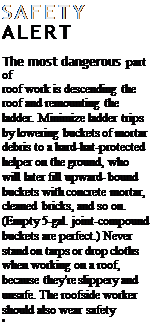About Chimney Fires
Chimney fires occur when imperfectly burned materials in wood smoke condense and stick to the inside of a chimney. The chief culprit in chimney fires is creosote, a sticky brown or black substance that may harden to resemble fragile glass. Incomplete combustion also produces tar, ammonia, methane, carbon monoxide, toluene, phenol, benzene, and eventually, turpentine, acetone, and methyl alcohol.

 If the chimney isn’t cleaned for a while, creosote accumulates until it’s heated enough to combust in a flash fire, often in excess of 2,000°F. For homeowners, a chimney fire is a terrifying experience, for it may literally roar for extended periods inside the entire flue, flames shooting skyward from the chimney top as though from an inverted rocket. If there are cracks in mortar or flue tiles—or no flue tiles at all—those superheated gases can "breach the chimney" and set fire to wood framing. At that point, the whole house can go up in smoke.
If the chimney isn’t cleaned for a while, creosote accumulates until it’s heated enough to combust in a flash fire, often in excess of 2,000°F. For homeowners, a chimney fire is a terrifying experience, for it may literally roar for extended periods inside the entire flue, flames shooting skyward from the chimney top as though from an inverted rocket. If there are cracks in mortar or flue tiles—or no flue tiles at all—those superheated gases can "breach the chimney" and set fire to wood framing. At that point, the whole house can go up in smoke.
Fortunately, you can prevent chimney fires, simply by inspecting and cleaning the chimney regularly. In general, don’t burn green (unseasoned) or wet wood. Give a fire enough air to burn completely. Each time you start a fire, open the dampers and air controls until the fire is burning well. Don’t burn Christmas trees (whose unburned resins collect as sticky masses inside flues), wrapping paper, or glossy-coated papers because their emissions can corrode stovepipes

![]()
After you’ve brushed the flues well, allow the dust and debris to settle before removing the plastic covering the fireplace and other openings. Shovel up the soot and debris at the bottom of each flue and from the fireplace; then vacuum all areas thoroughly. Don’t forget the soot that may be resting in thimbles or on the fireplace smoke shelf.
A masonry crown is a beveled flue collar at the top of the chimney, sloping gently to direct water away from flue tiles. When crowns weather and crack, water can drain between flue tiles and brick, seep into mortar joints, and freeze, thereby cracking flue tiles, bricks, and mortar joints. In warmer seasons, this water can leak into living spaces, stain walls, and linger as acrid combustion smells. Replacing the crown is easy enough if the chimney is not too tall—and the roof not too high or too steeply sloped. Otherwise, you’ll need rooftop scaffolding—which a pro should install—before tearing down the chimney to sound masonry and rebuilding from there.
Note: In warmer regions, uncovered flues and crowns are common. However, for winters in cold climates, flues should be capped to prevent the entry of rain and sleet that can damage flues during freeze-thaw cycles.
In most cases, a few hammer blows will dislodge old mortar crowns. Put the debris into a bucket. Then sweep the top of the chimney clean. If some mortar joints need repointing, attend to that. If many mortar joints are soft and badly eroded, tear down the chimney to the roofline, clean the bricks, install new flashing, and rebuild it. If bricks are cracked or broken, replace them with new SW grade bricks. It’s okay to reuse old bricks if they’re solid, but if you must replace more than a handful, rebuild the chimney with new bricks. They’ll look more uniform and last longer.
Installing a new crown. Spread sheet plastic around the base of the chimney to catch falling mortar. There are essentially two types of crowns. If your region gets a lot of precipitation, pour an in-place concrete crown, which overhangs the chimney 1 in. to 112 in. and acts as a drip cap, keeping rain and sleet off bricks near the top. Otherwise, use a trowel to build a sloping mortar crown that runs flush to the chimney faces. A flush crown isn’t as durable as an overhanging crown but is much quicker to build.
To construct an overhanging crown, as shown on p. 194, measure the outside dimension of the chimney top and build a frame from 2x2s that slides snugly over the chimney top. Shim from
below to wedge the frame in place so its upper face is flush to the top of the chimney. This 2×2 frame (actual dimension, 12 in. x 1 f2 in.) creates a 1h-in. overhang. Next, cut strips of plywood 3h in. wide and as long as the sides of the frame; using a cordless screwdriver, screw these strips to the frame so that they stick up 2 in. above the top of the frame. The resultant plywood frame keeps the concrete in place and creates a 2-in.-thick edge.
Wet the bricks with a brush or a spray bottle, and you’re ready for the concrete. Use a cement – rich, fairly stiff concrete mix: 1 part portland cement, 2 parts sand, and 2 parts %-in. gravel is about right. To prevent cracks, mix in a handful (!4 cup) of fiberglass fibers, which concrete suppliers carry. As you place the concrete into the plywood frame, use a trowel to force it into the corners and to drive out air pockets.
Important: Whether you build a mortar crown or pour a concrete one, wrap the flue liners with polyethylene bond-breaker tape or closed-cell foam strips. This prevents the mortar and concrete from bonding to the tile liners and thereby provides an expansion joint. Without this gap, heat-expanded flue tiles can crack a new crown in a single heating season.
If you’re building up a mortar crown, use a premixed mortar mix. For a slightly more flexible, crack-resistant crown, substitute a liquid latex fortifier for part of the water.
Both types of crowns should be sloped away from the flue liners and troweled to a smooth finish; and both will cure slower and stronger if you cover them with a damp burlap sack or plastic to protect them from rain and sun. Caulk the gap between the flue liners and the crown with a good urethane sealant.
Chimney caps should match the style of the house: chimneys on colonials and capes are often covered with slabs of bluestone bedded into corner tiers of mortared brick. Whereas, for newer homes or those with stainless-steel liners a stainless-steel or copper cap may be more appropriate. If there are multiple flue liners, you may need multiple caps or an overall custom cap.






Leave a reply